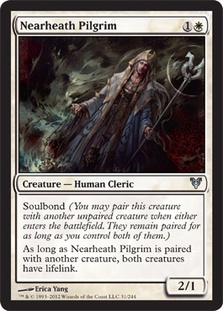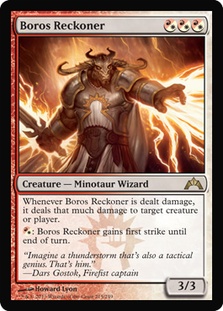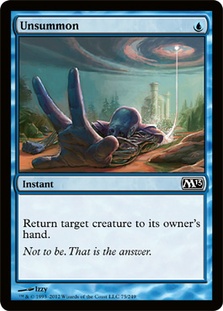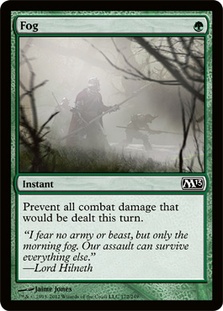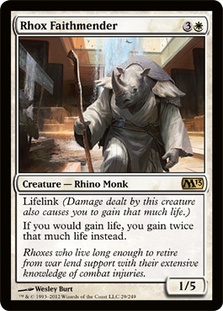I’ve used the phrased “set the stage” before without thinking deeply about its meaning. The StarCityGames.com Open in Atlanta set the stage for Standard in a very—not literal, of course, it’s still a metaphor—precisely apt way. This tournament provides the foundation from while we’ll watch Standard evolve and play out, likely changing every week, as we say in Return to Ravnica Standard. This is an exciting time to be following Standard. (Sorry about those Modern PTQs.)
Joseph Herrera won the event with a Naya deck that was very much a close descendent of the deck Ben Wienburg has been having success with, but with updated mana and Frontline Medic. His inclusion of three maindeck Nearheath Pilgrim is also certainly noteworthy.
Creatures (32)
- 3 Borderland Ranger
- 2 Fiend Hunter
- 4 Champion of the Parish
- 4 Avacyn's Pilgrim
- 4 Mayor of Avabruck
- 3 Thalia, Guardian of Thraben
- 3 Huntmaster of the Fells
- 4 Restoration Angel
- 3 Silverblade Paladin
- 2 Zealous Conscripts
Planeswalkers (2)
Lands (23)
Spells (3)

Creatures (31)
- 4 Champion of the Parish
- 4 Avacyn's Pilgrim
- 4 Mayor of Avabruck
- 3 Thalia, Guardian of Thraben
- 3 Huntmaster of the Fells
- 3 Restoration Angel
- 4 Silverblade Paladin
- 3 Nearheath Pilgrim
- 3 Frontline Medic
Lands (23)
Spells (6)

Winning the first event will obviously put a spotlight on a deck, but I’d argue that it’s not a significant indicator of a deck’s sustainability because he was playing in a room full of people who really didn’t know what to expect. Things will look very different when people know what to prepare for, and, worse yet, this deck is now the first priority to prepare for.
The second-place deck was Brian Braun-Duin (and Brad Nelson)’s Human Reanimator deck. I think we’ve seen this before—Brad “breaks it” with a graveyard deck, forcing people to respect Unburial Rites, and then the deck falls off a bit. This deck is probably more resilient than a deck that’s strongly invested in a three-mana 1/1, but at the end of the day, if everyone has Rest in Peace, you still won’t enjoy your tournament experience if you’re playing this deck.
Creatures (17)
- 4 Fiend Hunter
- 4 Huntmaster of the Fells
- 4 Angel of Glory's Rise
- 1 Cathedral Sanctifier
- 4 Cartel Aristocrat
Lands (23)
Spells (20)

That said, they were very successful this weekend, and it’s not like this is the first time anyone had seen Unburial Rites. Some people had Rest in Peace, and Brad and Brian were able to do well anyway. I myself would want to pay close attention to how much Rest in Peace I could expect before picking it up.
Third place was a mono-red deck that splashed two Boros Charms, which feels very odd to me. Once you’re going through the trouble of playing eight sources of white mana, why are you only playing two spells? Or, put differently, why are you going through the trouble of splashing for only two spells? The answer could easily be that they’re good and splashing is incredibly easy, and I’m fine with that, but is it really better than splashing green or black?
Creatures (26)
- 4 Stromkirk Noble
- 4 Hellrider
- 2 Stonewright
- 2 Lightning Mauler
- 2 Thundermaw Hellkite
- 4 Ash Zealot
- 4 Rakdos Cackler
- 4 Boros Reckoner
Lands (23)
Spells (11)
Sideboard

The fourth-place Jund Aggro deck is pretty exciting. It raises an interesting question about the direction of Jund in the future—far more people played a more traditional midrange Jund deck, but none of them did as well as Tyler Lindsey with his aggressive version. Now that people know about this version, will they switch?
Creatures (28)
- 4 Strangleroot Geist
- 4 Hellrider
- 2 Thundermaw Hellkite
- 3 Flinthoof Boar
- 4 Dreg Mangler
- 3 Deathrite Shaman
- 4 Experiment One
- 4 Ghor-Clan Rampager
Lands (24)
Spells (8)

The rest of the Top 8 showed an extremely diverse opening to the format but also little that I’d call radically new. People didn’t know what to gravitate to, and even if they did have new ideas, they probably didn’t have enough time to fine-tune them, so they either didn’t get played or didn’t do well.
So, with the stage set and introductions out of the way, it becomes our task to determine where we can expect things to go from here.
First of all, the top four decks (more than the top eight decks and more than a general average) were extremely proactive. Three of them were clearly aggro, and the fourth was basically what passes for combo these days.
The question is, is that because the format is tough on control players due to the extremely diverse threats and relatively narrow answers, or should we just always expect proactive decks to do better at the beginning of a format because controlling decks still don’t know what they need to attack?
The answer is that both of those are true.
Playing a control deck is extremely difficult right now. Here’s a cursory glance at the various constraints different threats put on you:
- Cavern of Souls means counterspells are unreliable.
- Thragtusk, Snapcaster Mage, Restoration Angel, Prime Speaker Zegana, and a variety of other creatures with powerful enters-the-battlefield triggers mean that letting a creature resolve and then dealing with it can be relatively ineffective.
- Hellrider, Thundermaw Hellkite, Dreg Mangler, Strangleroot Geist, Falkenrath Aristocrat, etc. mean that sorcery speed removal is suboptimal because you’ll already have been hit.
- Obzedat, Ghost Council makes sorcery speed removal entirely useless.
- Geist of Saint Traft makes targeted removal difficult to rely exclusively on, but undying and tokens make sacrifice effects unreliable.
- Boros Charm, Falkenrath Aristocrat, and undying creatures make Supreme Verdict unreliable.
- Planeswalkers need an entirely different set of answers than creatures.
- Even if you want to play removal, every card has significant limitations or costs a lot of mana.
- Burn and Ultimate Price are bad against Boros Reckoner.
- Victim of Night is bad against Vampire Nighthawk, Falkenrath Aristocrat, etc.
- Orzhov Charm is the closest we have to Terminate (as mentioned earlier, sorcery speed is deeply problematic, so Dreadbore isn’t the answer), but that comes with a serious life cost.
- Removal as a whole is almost entirely meaningless when your opponent is just going off in a single turn with Angel of Glory’s Rise, and instead you need to be able to fight the graveyard.
It’s just very hard to be a purely reactive deck.
Decks that are willing to try do get some powerful rewards, like Sphinx’s Revelation in the late game, but the format might just be too fast and diverse for reactive strategies to keep up.
If the correct conclusion is that the format is just a giant slugfest, then cards like Nearheath Pilgrim in the winning deck make a lot of sense.
Boros Reckoner also seems incredible right now. It’s a horrible card against sweepers, counterspells, and black or white removal, but if everyone is just burning things and attacking with creatures, the card is absolutely incredible.
So, where do we go? What should you play next? Well, if the top tables looked like this even though Jund Midrange was everywhere, I definitely wouldn’t personally be looking to try to kill all the creatures.
Unsummon was legal for over fifteen years before it saw regular tournament play, but after Vapor Snag showed us the power of that effect in modern Magic, it’s become something of a tournament staple.
Was it always that good?
Absolutely not. You might guess, at first, that if it’s so good now but wasn’t then, that maybe people don’t play it because they just didn’t know, but the reality is that Swords to Plowshares and Lightning Bolt existed in the beginning, and those were just better. Also, creatures weren’t as good; there are a lot of factors, but the short version is that—while there may have been a few points in time when Unsummon was slightly better than people realized—it just wasn’t there for the most part.
I bring this up to frame a question: Is Fog the next card to follow this path? It’s been around forever, but are we at the point where blocking and killing creatures are such weak plans, and racing is so important, that we just need to prevent damage to buy the critical turn to win the race?
We talked about that effect as the possible trump in Innistrad Block Constructed for the Hexproof mirror, but I can imagine it becoming a real card in Standard. Strange times.
Maybe I’m getting too theoretical; let me get a bit more concrete.
Why did this Naya deck win? When Patrick Sullivan first saw Ben Wienburg Naya Humans list in the Top 8 of the StarCityGames.com Invitational, I felt like he wanted to write a treatise on how badly the deck was constructed, and yet it keeps performing. What’s going on here?
Well, the deck manages to pack enough aggression to kill people who aren’t sufficiently prepared for an aggressive G/W Humans draw. It turns out, that’s a reasonable number of people.
But when it’s paired against someone who’s trying to race or any other creature deck, I’m guessing we see serious results from the little bit of life gain in the deck. Nearheath Pilgrim is hard to race, as is Huntmaster of the Fells, and if you can’t attack, Champion of the Parish makes a good wall for you to sit behind while generating value with Huntmaster of the Fells (with possible help from Restoration Angel).
When I’m trying to race, I definitely wouldn’t want to play an aggressive deck that has little control over the pacing, like Zombies. I’d rather have a deck that can block and gain life like this one in a format where resilience and speed are potentially less important than creature battles.
My takeaway from this is that, for now, you probably want to be aggressive, but you want to find subtle, incidental, powerful ways to interact in a race. The trick is to find the proper metric of interactions. Life gain and additional blockers is a good one, but what are others?
Fog, I already suggested; Rhox Fatihmender is just life gain, but it’s somewhat special because it’s so good at blocking. Unsummon is a good tempo play that can interact with Boros Reckoner, which I can easily imagine becoming the order of the day.
What else? Maybe something like Gruul Charm, used primarily as a Falter. It’s narrow and not the kind of effect we generally think about for Constructed, but if everyone’s playing creatures and we’re just trying to end games, why not? Those effects have always been great at ending games in Limited.
Of course, there’s always the possibility that the best solution is to think like Brad Nelson. What if, instead of trying to find a tricky way to win in combat, you found a proactive strategy that let you ignore combat? The graveyard has been one obvious way to do it but not the only way. The huge mana Door to Nothingness decks operate on a similar principle—they’re just trying to do something so big it wins any game before the opponent can. After all, Ranger’s Path is a much better card now that it can find any color.
Making a lot of tokens is another strategy that has been successful in the past that can match up very well against creatures. As long has you have Intangible Virtue so that the tokens can actually fight, few things feel worse than drawing a creature that is worse than one fourth of the creatures your opponent made with their Lingering Souls.
With a format this diverse, it’s easy to follow a line of thought that says, “A format can’t sustainably be this diverse. One deck has to be more powerful, and it will rise to the top because the opponent will just be playing whatever.” So people should just pick the best deck until everyone has to adapt, but we don’t actually have evidence that this format has a best deck, and we definitely don’t have evidence that it’s already been discovered. So for now, I would advocate trying to build new decks—I’d argue that maybe this format isn’t diverse enough!
If you were looking for an enemy and a metagame to try to attack, you have it: If you can beat a variety of aggressive creature strategies reliably, you should do extremely well. That’s really all you have to do. Yes, there are control decks that people play that could beat you anyway, but right now, they’re in such a minority that I’d argue that you don’t need to worry about them much.
That will change, of course, but not before someone wins something with a control deck.
For now, you have your mission: Beat small creatures. That shouldn’t be too difficult.
Good luck.
Thanks for reading,
Sam
@samuelhblack on Twitter

